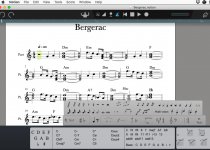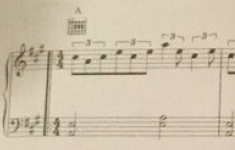Thanks for this new section of the forum!
I thought I’d start a thread about sheet music notation software that folks find helpful. It might be good to share tips / experiences etc.
I’ve been using Notion (available for Mac, Windows and iOS) for a bit over a year now. I tried a trial copy of Sibelius and a few others, but Notion was the one that clicked for me. It can be used for full orchestral scale scores, but I use it primarily to record accordion melodies (with harmonies/embellishments) plus a note of the chords to play at each point. You can do a full bass clef arrangement for a more complex or fuller accordion music notation, but I like this short hand, and most of the time it’s enough for what I want to play, and very compact. Here’s a screenshot:

I mainly do the arranging on my laptop, but sometimes use my Mac desktop, iPad or iPod touch (iPhone minus the phoning), which all sync music between them. My music theory knowledge is um shaky, so I’m spotting music things I recognise rather than knowing what everything is called properly! But it works. And I sometimes use a mini USB piano keyboard to experiment with as I’m arranging. I’ve written more about this in my blog.
As a disabled accordionist, who can only play occasionally now due to progressive neurological illness, arranging like this with computer music software has reinvigorated my accordion playing, letting me have fun creatively working on arrangements, and also do them when too weak to play. I was never keen on writing music by hand/pen/pencil even when my hands worked properly. Now it's not an option, but thankfully the sheet music software gives me a good alternative.
Anyway would be interested to know what tools other people use. Thanks all!
I thought I’d start a thread about sheet music notation software that folks find helpful. It might be good to share tips / experiences etc.
I’ve been using Notion (available for Mac, Windows and iOS) for a bit over a year now. I tried a trial copy of Sibelius and a few others, but Notion was the one that clicked for me. It can be used for full orchestral scale scores, but I use it primarily to record accordion melodies (with harmonies/embellishments) plus a note of the chords to play at each point. You can do a full bass clef arrangement for a more complex or fuller accordion music notation, but I like this short hand, and most of the time it’s enough for what I want to play, and very compact. Here’s a screenshot:

I mainly do the arranging on my laptop, but sometimes use my Mac desktop, iPad or iPod touch (iPhone minus the phoning), which all sync music between them. My music theory knowledge is um shaky, so I’m spotting music things I recognise rather than knowing what everything is called properly! But it works. And I sometimes use a mini USB piano keyboard to experiment with as I’m arranging. I’ve written more about this in my blog.
As a disabled accordionist, who can only play occasionally now due to progressive neurological illness, arranging like this with computer music software has reinvigorated my accordion playing, letting me have fun creatively working on arrangements, and also do them when too weak to play. I was never keen on writing music by hand/pen/pencil even when my hands worked properly. Now it's not an option, but thankfully the sheet music software gives me a good alternative.
Anyway would be interested to know what tools other people use. Thanks all!


